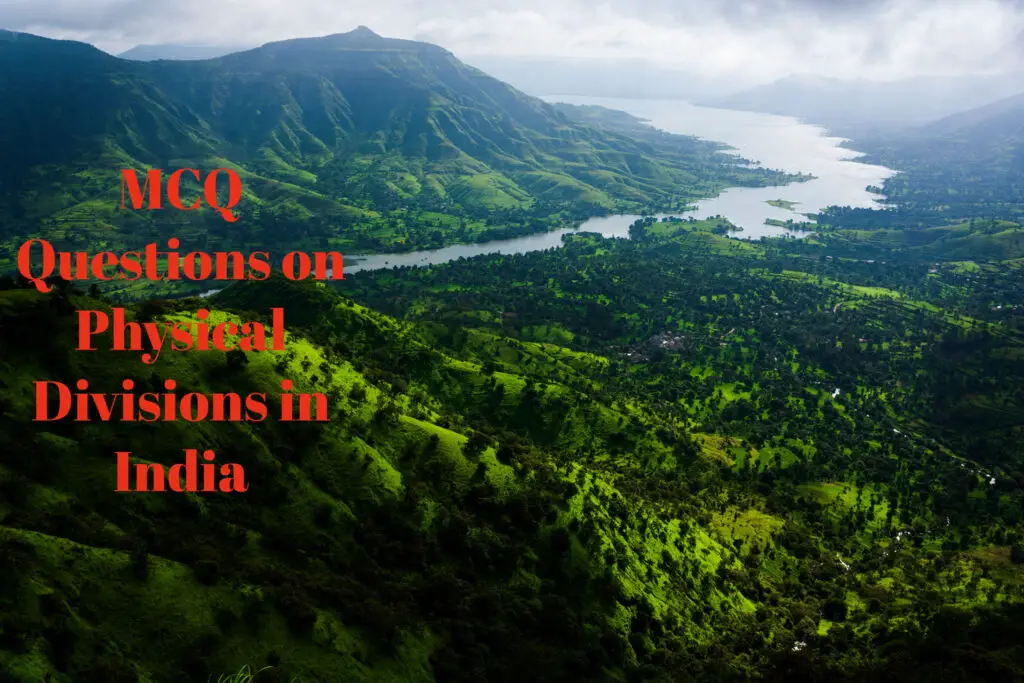Are you making yourself ready for the upcoming examinations? In this article, I will display some Multiple-Choice Questions on Physical Divisions in India that will boost you in examinations and viva. Also, I will give one Worksheet on Physical Divisions in India. you may practice the same by solving the worksheet.
The last section will be a Quiz on Physical Divisions in India. Appear for the test and fall in love with studying many objective-type questions.
You will find a downloadable PDF button at this MCQ sheet’s end. Click here to download the PDF version of this sheet.
Now, let’s start with the objective-type questions or Oral questions.

MCQ questions or Viva Questions on Physical Divisions in India for class 4
- The major portion of West Bengal falls under:
- The Northern Mountains
- The Peninsular Plateau
- The Coastal Region
- The Northern Plains
Ans: (4)
- There lies a huge mountain range in the northern part of India, called the:
- Himalayas
- Mount Everest
- Nilgiri
- None of these
Ans: (1)
- Khasi hills are located in the
- Southwest of India
- Southeast of India
- Northwest of India
- Northeast of India
Ans: (4)
- The highest mountain peak of the Himalayas is:
- Himalayas
- Mount Everest
- Nilgiri
- None of these
Ans: (2)
- Mount Everest is situated in
- West Bengal
- Bhutan
- Nepal
- Bangladesh
Ans: (3)
- The Himalayas can be divided into:
- Five categories
- Four categories
- Three categories
- Two categories
Ans: (3)
- Which portion of the Himalayas has extremely cold weather?
- Himadri
- Himachal
- Shiwalik
- None of these
Ans: (1)
- Which of the following area is known as the ‘food bowl of India’?
- The Desert
- The Peninsular Plateau
- The Northern Plains
- The Coastal Region
Ans: (3)
- In which portion of the Himalayas, the weather is warm in Summer and cool in Winter?
- Himadri
- Himachal
- Shiwalik
- None of these
Ans: (3)
- Which portion of the Himalayas receives cool Summer and cool Winter?
- Himadri
- Himachal
- Shiwalik
- None of these
Ans: (2)
- The largest river in India is:
- Yamuna
- Ganga
- Brahmaputra
- Kaveri
Ans: (2)
- The soil of the Northern Plain is ideal for the cultivation of
- Sugarcane
- Wheat and rice
- Tea leaves
- None of these
Ans: (2)
- The __ acts as a barrier to protect our country from the cold winds.
- Chota Nagpur Plateau
- Himalaya
- China border
- Islands
Ans: (2)
- Major river basins in the Northern Plains are formed by the __river in the east, __river in the center, and __ river in the west.
- Brahmaputra, Ganga, Indus
- Indus, Ganga, Brahmaputra
- Ganga, Brahmaputra, Indus
- Indus, Ganga, Brahmaputra
Ans: (1)
- The northwestern part of India is:
- Hot and humid
- Dry and sandy
- Cold and humid
- None of these
Ans: (2)
- Which of the following rivers flow from west to east in the Peninsular Plateau?
- Mahanadi and Godavari
- Narmada and Tapi
- Ganga and Yamuna
- None of these
Ans: (1)
- Which of the following rivers flow from east to west in the Peninsular Plateau?
- Mahanadi and Godavari
- Narmada and Tapi
- Ganga and Yamuna
- None of these
Ans: (2)
- Which region is known as the storehouse of minerals in India?
- The Desert
- The Peninsular Plateau
- The Northern Plains
- The Coastal Region
Ans: (2)
- The black soil in __ region is suitable for growing cotton.
- The Malwa Plateau
- The Chota Nagpur Plateau
- The Deccan Plateau
- The Coastal Region
Ans: (3)
- The largest coal-producing belt in India lies in the __ region.
- The Desert
- The Peninsular Plateau
- The Northern Plains
- The Coastal Region
Ans: (2)
- Which area is the main producer of hydroelectricity?
- The Desert
- The Peninsular Plateau
- The Northern Plains
- The Coastal Region
Ans: (2)
Worksheet on Physical Divisions in India (F.M=30)
Short Questions: 6×2=12
- Write the name of the six numbers geographical regions of India.
- Name some states and union territories of India that are located in the Northern Mountains.
- How many regions the Himalayas can be divided into and what are those?
- Write the range of the Himalayas.
- How can you differentiate the different regions of India with respect to the weather?
- Write the importance of the Himalayas.
Tick the correct answer and fill in the blanks. 8×1=8
- The Himalayas extends from __ in the north to __in the east.
- The highest mountain peak is __ situated in __.
- The great Indian desert is __.
- The sand dunes are found in __areas.
- The Deccan Plateau region is rich in black soil which is suitable for growing __.
- The __ region is neither hot nor cold.
Write a short note on the following: 5×2=10
- Northern plains
- The desert
- The peninsular plateau
- Coastal region
- Islands
Quiz on Physical Divisions in India
Here is the Quiz on Physical Divisions in India:
Overview
Here I am going to describe the important features of four main regions in tabular format so that you can easily remember:
| Sl no | Name of the region | Surroundings Area | Climate | Type of soil | Crops/fruits | trees | region |
| 1 | Northern Mountains | From Jammu and Kashmir in the north to Arunachal Pradesh in the east | Extreme cold in Himadri, cool summer and cold winter in Himachal, warm summer and cool winter in Shiwalik | – | Apples and peaches in Himachal | Pine, deodar, oak in Himachal, potato, rice, and wheat in Shiwalik | J&K, Ladakh, H.P, Uttarakhand, Sikkim, A.P, Northern part of W.B |
| 2 | Northern Plains | From south of the Himalayas to the North of the Deccan Plateau | Hot summer, cold winter | Fertile alluvial | Wheat, rice | Peepal, Banyan, Neem, Sheesham, Eucalyptus | Punjab, Haryana, Assam, Uttar Pradesh, West Bengal. Union territory-Delhi |
| 3 | The Desert | The northwestern part of India | no rainfall; hot and dry in the day and very cold at night | Dry and sandy | Cotton, oil seeds, millet | Cactus, acacia | Mostly Rajasthan and some parts of Gujrat |
| 4 | The Peninsular Plateau (storehouse of minerals in India) | Towards the south of India separated from the Northern Plains by Vindhya and Satpura range of hills | Hot summer, cold winter | Deccan Plateau- black soil | Cotton, | Thorny scrub forest, broad-leafed trees | M.P, Chhatisgarh, Jharkhand, Telangana, parts of Tamilnadu, Karnataka, Maharastra, A.P, Odisha |
| 5. | The Coastal Region | Eastern part-between the Bay of Bengal and the Eastern Ghats. Western part – between the Arabian sea and the Western Ghats | Neither too hot nor too cold; Hot, humid summer, mild winter. Southern part-rain in winter. Hilly regions are cooler than plain areas | – | – | – | T.N, A.P, Odisha- eastern side Kerala, Karnataka, Goa, and Maharastra- western side |
| 6. | The Islands | Andaman and Nicobar Islands in the Bay of Bengal and the Lakshadweep Islands in the Arabian Sea | Hot, humid summer and mild winter | – | rice | Coconut, woody climbers, orchids, a variety of Ferns | A&N, Lakshadweep |
Rivers:
In the Northern Plains: Ganga, Brahmaputra, Indus
In the Peninsular Plateau: Krishna, Kaveri, Mahanadi, Godavari (flow from west to east), Narmada, and Tapi (flow from east to west)
In the Coastal Region: Mahanadi, Godavari, Krishna, Kaveri. Narmada and Tapi in the western part of this region.
Conclusion
I hope that the Multiple-Choice Questions on Physical Divisions in India will help you in your school examinations and different types of competitive examinations. If you have any queries on Physical Divisions in India, please make me lucky by answering your questions. Best wishes, Children! Wish you a great career ahead!


